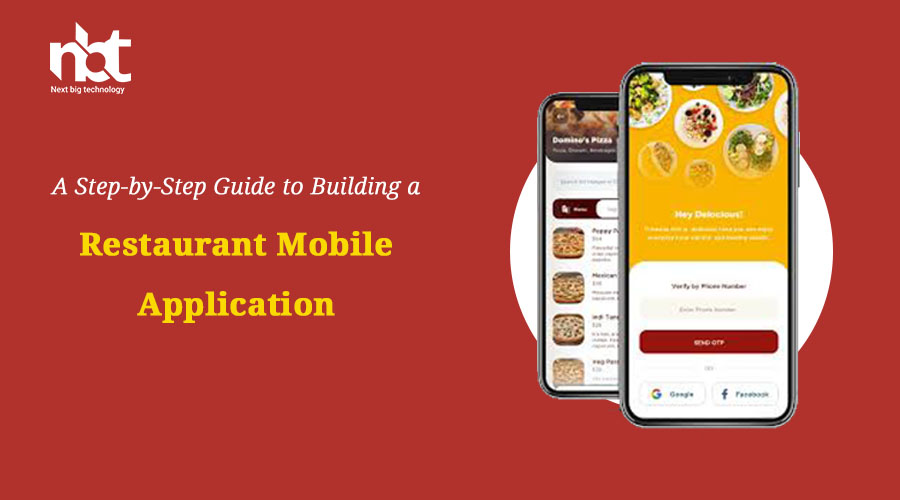Introduction:
In today’s digital age, restaurants are increasingly leveraging mobile applications to enhance customer experiences, streamline operations, and boost their online presence. A restaurant mobile application allows customers to easily browse menus, place orders, make reservations, and engage with the restaurant, all from the convenience of their smartphones. If you’re considering building a restaurant mobile application, this comprehensive guide will walk you through the step-by-step process. From defining your app’s objectives to designing the user interface, integrating essential features, and launching your app, we’ll cover everything you need to know. Let’s get started!
- Define Your App’s Objectives and Features:
Before diving into development, clearly define your restaurant mobile application’s objectives and the features you want to include. Consider functionalities such as menu browsing, online ordering, table reservations, loyalty programs, push notifications, customer reviews, and integration with social media platforms. Identifying your app’s objectives and features upfront will guide the development process and ensure you create a tailored solution for your restaurant.
- Understand Your Target Audience:
To build a successful restaurant mobile application, it’s crucial to understand your target audience. Consider their demographics, preferences, and behaviors when designing the app’s user interface and feature set. For example, if your target audience consists of tech-savvy individuals, you may want to incorporate advanced features such as in-app payment options or personalized recommendations.
- Choose the Right Development Approach:
There are two primary approaches to building a restaurant mobile application: native or cross-platform development. Native development involves creating separate applications for different platforms (e.g., iOS and Android) using platform-specific languages (Swift for iOS, Java or Kotlin for Android). Cross-platform development utilizes frameworks like React Native or Flutter to build a single codebase that runs on multiple platforms. Consider the pros and cons of each approach to determine the best fit for your restaurant’s needs.
- Design the User Interface (UI) and User Experience (UX):
Designing an intuitive and visually appealing user interface is critical for a restaurant mobile application. Start by creating wireframes and prototypes to visualize the app’s layout and user flow. Pay attention to elements such as menu navigation, order placement, reservation booking, and visual representation of menu items. Aim for a seamless and delightful user experience that reflects your restaurant’s branding and enhances engagement.
- Implement Essential Features:
Once you’ve defined your objectives, features, and UI/UX design, it’s time to start development. Begin by implementing the essential features of your restaurant mobile application. This typically includes functionalities such as menu browsing with detailed item descriptions and images, online ordering with customization options, table reservation with real-time availability, and integration with popular payment gateways to facilitate seamless transactions.
- Integrate Additional Features:
To differentiate your restaurant mobile application and provide a comprehensive user experience, consider integrating additional features. These may include:
a. Loyalty Program: Implement a loyalty program to reward frequent customers and encourage repeat visits. Offer points, discounts, or special promotions to enhance customer engagement and foster loyalty.
b. Push Notifications: Utilize push notifications to send timely updates, promotions, or personalized offers to app users. Keep customers informed about new menu items, events, or special discounts to increase their engagement with your restaurant.
c. Customer Reviews and Ratings: Allow customers to leave reviews and ratings directly within the app. This not only encourages user-generated content but also provides valuable feedback for your restaurant and helps build trust among potential customers.
d. Social Media Integration: Integrate your restaurant’s social media accounts within the app to encourage social sharing, increase brand visibility, and facilitate seamless user interactions.
- Ensure Seamless Performance and Security:
A restaurant mobile application must deliver a seamless performance and maintain the security of user data. Optimize your app’s performance by minimizing loading times, optimizing images, and implementing caching techniques. Employ robust security measures to protect user information, including secure authentication and encryption of sensitive data like payment details.
- Test, Iterate, and Refine:
Testing is crucial to ensure your restaurant mobile application functions as intended across various devices and operating systems. Conduct thorough testing to identify and fix any bugs, usability issues, or compatibility problems. Gather user feedback and iterate on the app’s design and functionality to continuously improve the user experience.
- Publish and Promote Your App:
Once you’ve thoroughly tested and refined your restaurant mobile application, it’s time to prepare it for launch. Register developer accounts with the relevant app stores (e.g., Apple App Store and Google Play Store) and submit your app for review. Follow the app store guidelines, optimize your app’s description, screenshots, and keywords, and leverage marketing techniques to promote your app to your target audience.
- Monitor, Update, and Maintain:
Launching your restaurant mobile application is just the beginning. Continuously monitor user feedback, app performance, and customer engagement metrics to identify areas for improvement. Regularly update your app with new features, bug fixes, and security patches. Consider implementing analytics tools to gain insights into user behavior and preferences, allowing you to refine your app and provide an even better user experience.
Conclusion:
Building a restaurant mobile application requires careful planning, thoughtful design, and robust development. By following the steps outlined in this guide, you can create a powerful tool that enhances your restaurant’s visibility, engages customers, and streamlines operations. Remember to define your app’s objectives, understand your target audience, choose the right development approach, design an intuitive UI/UX, implement essential and additional features, ensure performance and security, thoroughly test and refine, publish and promote, and continuously monitor and update your app. With dedication and attention to detail, your restaurant mobile application can become a valuable asset in attracting and retaining customers in today’s digital age.









